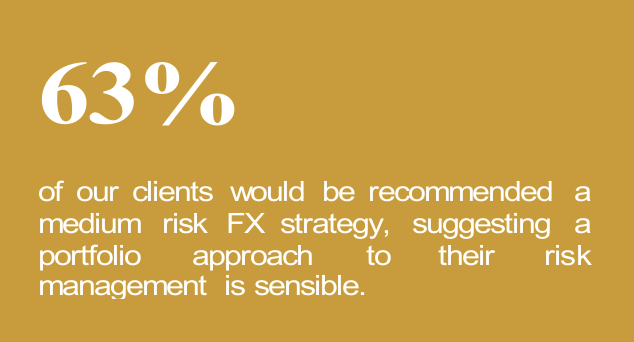Britain’s economy was sent back to the year 2002 after the first lockdown caused output to shrink by a quarter. After an initially stop‑start recovery, the early and swift vaccine rollout has enabled the rapid removal of restrictions. This has put GDP on the cusp of regaining its pre‑pandemic level. However, there are various headwinds that threaten to blow the recovery off course. Key amongst these is the new Omicron variant, which scientists fear could be more transmissible and vaccine‑resistant than the Delta strain.
Britain’s economy is back on track, but challenges remain
Currently, UK GDP is just 0.6% smaller than it was before COVID-19. This gap should be eliminated around the turn of the year, provided that stringent restrictions aren’t re‑imposed. But the high rate of inoculation should ensure this will not be necessary. Over 80% of the UK population have received their second dose, whereas 1 in 4 have received a booster vaccination. Still, the emergence of the Omicron variant poses a notable threat. It will be weeks until we know how much of a risk it presents (i.e. compared to the Delta strain), but the imminent extension of ‘boosters’ to all adults should help to diminish this.
Beyond this, growth should continue to moderate in 2022 as the initial reopening boost fades further. A major headwind is set to be the persistent disruption to global supply chains. Bottlenecks have arisen as a broad‑based, robust recovery in global demand has caused congestion at ports, leading to delays in the delivery of goods. Further exacerbating this has been various virus‑related disruptions at major Asian ports and factories.
How long the disruption to global supply chains will last is uncertain. Anecdotal feedback collated by the Bank of England’s agency network suggests it could continue until at least mid-2022 and may even spillover into H2. A key factor here will be how quickly consumption rotates from goods and back towards services, as is how persistent the current challenges in filling vacant positions proves.
After a historic drop, is GDP Back to the Future?
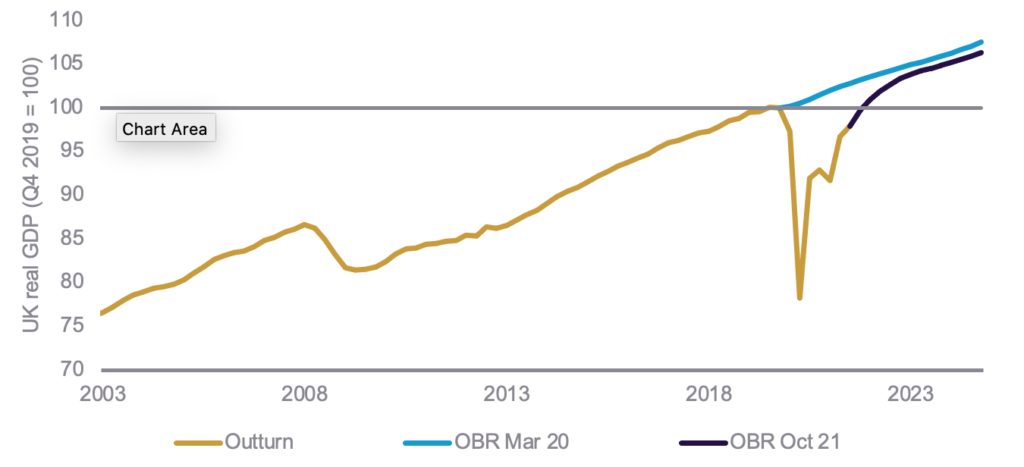
Chart compares the March 2020 and October 2021 forecasts for UK GDP from the Office for Budget Responsibility. Source: ONS, OBR
Surveys show no let up in the current supply chain woes
Calculated as the difference between the supplier delivery times sub-component of the PMI and a counterfactual, cyclical measure of supplier delivery times based on the manufacturing output sub-index. Source: IMF, IHS Markit
These factors should result in a slower pace of UK GDP growth next year; the Bloomberg consensus is for it to moderate to 5.0% in 2022 after an expected 7.0% expansion in 2021. We judge that the balance of risks to the outlook is tilted to the downside, with the Omicron variant presenting a key source of uncertainty. Even so, the robustness of the recovery means the economy is now converging back to its pre‑pandemic path. The gap between the OBR’s latest GDP forecasts and what it published in March 2020 halves from around 4% this year to 2% in 2022 and again to just 1% in 2023.
Transitory inflation could well prove persistent
Inflation is back with a vengeance in the UK; the annual rate of CPI reached a 10-year high of 4.2% in October, having started the year at a comparatively tame 0.7%. Its rapid ascent to more than double the Bank of England’s 2% target has come as a surprise to many, including the central bank itself. Back in February, it assumed it would currently be about 2%, but its most recent set of projections now see it peaking at around 5% in April 2022. So why has inflation confounded expectations so much?
- Energy prices Oil and gas prices have climbed on the back of the global recovery, with the latter also impacted by low stockpiles owing to supply disruptions.
- Supply chains Tradeable goods prices have risen sharply this year as supply struggled to meet the global rebound in demand, as have the costs of shipping them.
- Base effects Last year, the price of many goods and services declined. This has meant even modest price rises this year have had a large upward impact on CPI.
But these price pressures should prove transitory. Supply chain strains ought to ease, leading to something of a normalisation in international trade costs. Wholesale energy prices are also set to fall back as demand cools and supply constraints dissipate. Multiplying these disinflationary trends will be the ‘base effect’ flipping the other way in 2022 as falling prices are set against the rises seen throughout this year. For these reasons, the Bank of England estimates the annual rate of CPI will gradually ease over the second half of next year and will stand close to target by the end of 2023.
However, a cause for concern is whether second‑round effects emerge. For instance, consumers’ inflation expectations have drifted higher, with the year‑ahead measure of the Citi/YouGov survey climbing sharply over this year to now stand at the highest since 2008.
Inflation: here today, gone tomorrow?
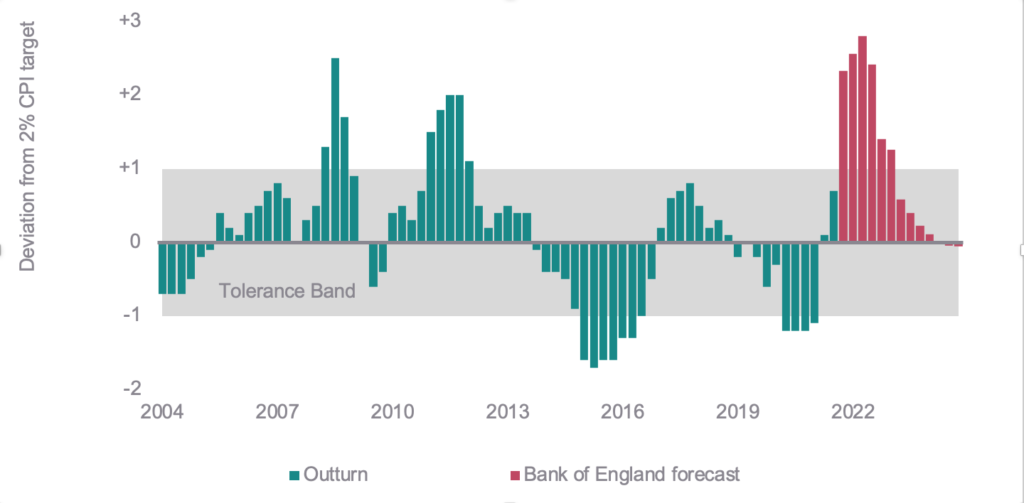
The Governor of the Bank of England is required to write an explanatory letter to the Chancellor of the Exchequer if CPI inflation deviates more than 1 percentage point from the MPC’s 2% target. The shaded area on the chart illustrates this implicit ‘tolerance band’. Source: ONS, Bank of England
If expectations become ‘de‑anchored’, consumers may become more tolerant of price increases which then risks above‑target inflation becoming embedded. Workers may also demand higher wages to compensate for the squeeze on real incomes, which are more likely to be awarded by employers given the persistent difficulties in matching jobs with workers.
What will the final furlong for furlough mean for jobs?
Although the economy was hit hard by the pandemic, the labour market has been shielded by the Coronavirus Job Retention Scheme (CJRS). A total of 11.7mn jobs have been furloughed, including 8.9mn at its peak. As a result, the unemployment rate was 4.3% in Q3, just 0.3 percentage points higher than it was before the pandemic. However, there were still 1.1mn jobs covered by the scheme when it was wound up in September, of which 56% were fully furloughed.
This is concerning considering most restrictions have now been rolled back. As an illustration, if 0.5mn people find themselves out of work following the end of furlough, this would (other things equal) cause the unemployment rate to climb to 5.7%, the highest since early‑2015. But the evidence so far suggests there have not been widespread layoffs. Businesses report that less than 3% of furloughed employees were made redundant at the end of the scheme, whereas HMRC figures show a net rise of 160k employees enrolled onto PAYE in October. At the same time, the ratio of vacancies to unemployed people reached the highest level since figures began in 2001. Surveys also indicate that recruitment difficulties are becoming increasingly acute across a broad range of sectors and occupations. So why were so many workers still furloughed amidst such fierce competition for labour?
It is a complex puzzle and one that we do not currently have all the answers for. Firms hiring and hoarding workers in anticipation of higher demand and/or recruitment difficulties in 2022 is likely to be part of the story, as is lower immigration owing to a combination of Brexit and COVID‑19. We also suspect there is some permanency to the shift in spending patterns brought about by the pandemic, which will require workers to move across sectors and occupations in a meaningful way. While the flexibility and dynamism of the UK’s labour market should reconcile these issues in due course, for the meantime we expect hiring to remain challenging for much of next year.
Labour market frictions re extremely elevated

Ordinarily when labour demand rises, unemployment falls and job vacancies increase. Beyond the furlough distortions of 2020, the sharp upward line for 2021 compared to the flatter profile of previous years suggests it has become far more difficult to fill open positions for the same level of unemployment. Source: ONS
Wage growth is being distorted, but could prove sticky
Recently we have seen a moderation in wage growth, although it remains elevated by historical levels. But just like inflation, pay is being affected by transitory factors:
- Furlough effect Workers on the furlough scheme were paid 80% of their usual salary and rarely received a top‑up from their employer(s). This had the effect of pushing down on average wages in 2020.
- Compositional effect Many of the jobs lost as a result of the pandemic have generally been in lower‑paid occupations whereas better paying roles have proved more adaptable (e.g. remote working). This has had the effect of pushing up on average wages.
Estimates of underlying wage growth suggest that it is weaker than the headline series but is nevertheless running above its average for the past decade. One probable reason for this is that employees who faced a pay freeze in 2020 are being compensated with an above average wage increase this year. But it is also likely to be a symptom of the war for talent, as employers fight to hire and/or retain staff with skills in particularly high demand. Although we expect the pay pressures to ease over 2022, they are likely to remain somewhat elevated until the current labour market frictions can be ironed out.
Underlying wage growth is softer but above average
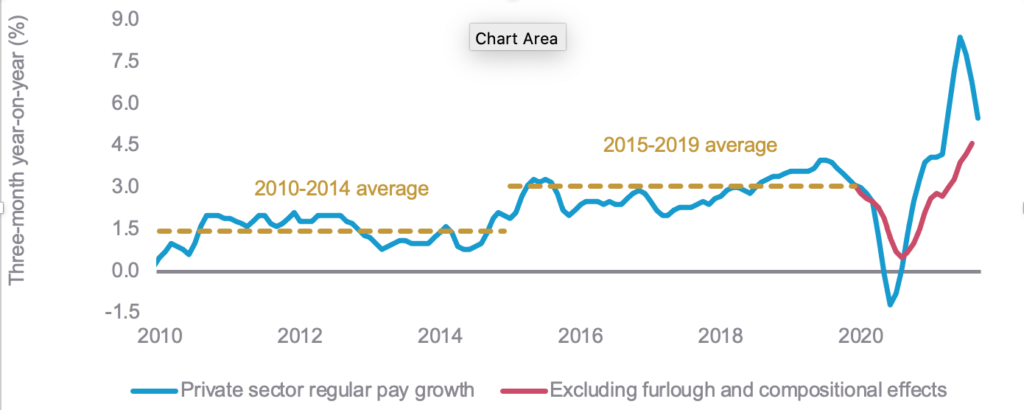
So‑called regular pay does not include bonuses paid out to employees, providing a clearer picture of underlying pay conditions. Source: ONS, Bank of England
You can Bank on interest rates rising in 2022
Investors had expected the Bank of England’s MPC to raise borrowing costs in November to nip rising inflation
expectations in the bud. But instead a 7-2 majority of the committee elected to wait and see whether the furlough scheme would lead to a large rise in unemployment. Subsequent evidence suggests that it has not, but the official labour market data is not scheduled to be released until the week of the 16 December decision. Providing this does not show anything more than a modest rise in unemployment, we suspect committee will sanction a rise in Bank Rate from 0.10% to 0.25%.
This is likely to be followed by further hikes in 2022 to take out additional insurance against the second‑round effects previously described. Consensus expectations are for Bank Rate to rise by 25 basis points at both the April and November meetings to place it at 0.75% by the end of the year. Money markets remain of the view that it should even reach 1.00%. While the difference between the two is not material, the latter could see the MPC take a more significant step towards policy normalisation.
However, the MPC has also signalled that it will consider actively selling its stock of purchased assets once Bank Rate reaches 1.00%, dependent upon economic circumstances at the time. If investors are right and economists are wrong, there could be greater degree of quantitative tightening (or QT) in 2022.
BoE as never done QT, that could change next year
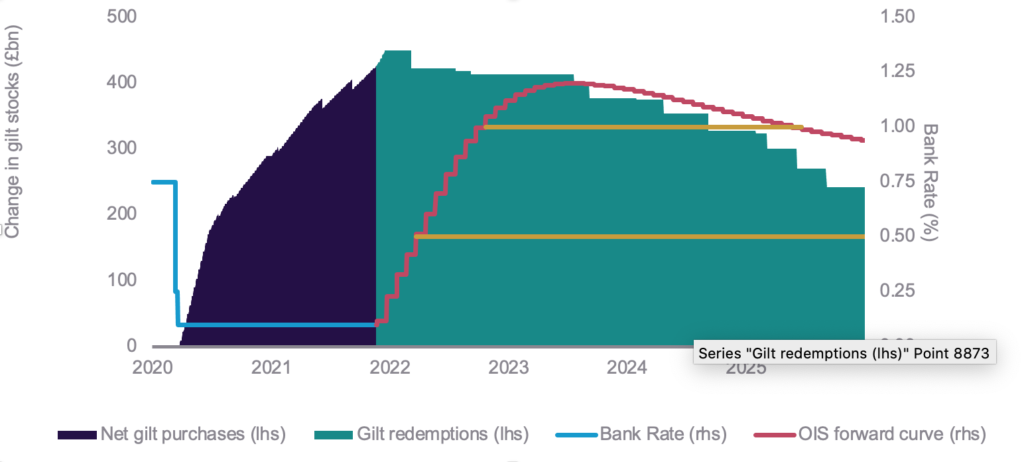
The two gold lines on the chart denote the dates that markets are pricing in when Bank Rate will reach 0.50% and 1.00%. These are the respective levels at which the MPC will stop the reinvestment of maturing gilt assets and at which it will consider actively selling the stock. Source: Bank of England
